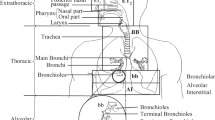Abstract
The two real-time numerical models of the spreading of a cloud of gas-aerosol impurity in the atmosphere are presented: a Lagrangian model and a model based on the method of moments of the concentration fields. It was shown that in most empirical relations for the relative variances of the impurity concentration fields in a cloud the contribution of wind shears is strongly overestimated and that the coefficient of proportionality in each term of the formulas for the transverse variance is approximately d v = 0.036, but not 1/6, as in the early works. The models were used to estimate the proportionality coefficient d v ∼ 0.05–0.1 in the formulas for the longitudinal relative variance.
The numerical experiments also showed that the natural variability of wind fields strongly affects the position of spots on the ground and the contamination levels produced as result of instantaneous impurity emissions from high sources. 1 figure, 1 table, 18 references.
Similar content being viewed by others
REFERENCES
"Taking account of the dispersion parameters of the atmosphere when choosing sites for nuclear power plants," Safety Manual No. 50-SG-S3, IAEA, Vienna (1982).
"Safety and nuclear power. Part 1," 1st edition, Standardization-technical document 38.220.56–84, Interatoménergo, Vol. 1, Énergoatomizdat, Moscow (1984).
Manual for Establishing Admissible Emissions of Radioactive Substances into the Atmosphere [in Russian], Moscow (1989).
S. P. Beschastnov and A. V. Naidenov, "Estimates of the spatial variability of the wind field for a radiation monitoring system in Obninsk," Met.Gidrol., No. 3, 33–43 (1998).
S. P. Beschastnov and A. V. Naidenov, "Diffusion models of a gas-aerosol impurity plume for local radiation monitoring systems," At.Énerg., 88, No. 6, 464–470 (2000).
A. A. Kostrikov, "Model of long distance impurity transport," Met.Gidrol., No. 11, 60–65 (1988).
E. K. Garger, "Estimate of the variances of the coordinates of impurity particles in the mixing layer," Trudy IÉM, No. 29 (103), 11–25 (1984).
N. L. Byzova, E. K. Garger, and V. N. Ivanov, Experimental Investigation of Atmospheric Diffusion and Calculation of Impurity Spreading [in Russian], Gidrometeoizdat, Leningrad (1991).
U. Hogstrom, "An experimental study on atmospheric diffusion," Tellus, 16, No. 2, 205–251 (1964).
F. Smith, "The role of wind shear and horizontal diffusion of ambient particles," Quart.J.Roy.Met.Soc., 91, No. 2, 205–251 (1965).
P. Saffman, "The effect of wind shear on the horizontal spread from instantaneous ground source," ibid., 88, No. 378, 382–393 (1962).
N. L. Byzova, G. P. Zhukov, N. F. Mazurin, and B. S. Yurchak, "Experimental estimates of the diffusion parameters of a passive impurity from an instantaneous high source in the lower part of the atmospheric boundary layer," Trudy IÉM, No. 57 (159), 3–17 (1994).
G. P. Zhukov and B. S. Yurchak, "Diffusion of a passive impurity in the atmospheric boundary layer according to radar data," Izv.Akad.Nauk, Fiz.Atmos.Okeana, 30, No. 4, 451–457 (1994).
D. Randerson, "Temporal changes in the horizontal diffusion parameters of a single nuclear debris cloud," J.Appl.Met., 11, 670–673 (1972).
J. Angell, P. Allen, and E. Jessup, "Mesoscale relative diffusion estimates from tetroon flights," ibid., 10, 43–46 (1971).
S. Kao and L. Wendell, "Some characteristics of relative particle dispersion in the atmospheric boundary layer," Atm.Env., 2, 397–407 (1968).
K. Peterson, "Continuous point source plume behavior out to 160 miles," J.Appl.Meteor., 7, 217–226 (1968).
Meteorology and Atomic Energy [Russian translation], Gidrometeoizdat, Leningrad (1971).
Author information
Authors and Affiliations
Rights and permissions
About this article
Cite this article
Beschastnov, S.P., Naidenov, A.V. Diffusion Models of an Impurity Cloud for Real-Time Calculations in Local Radiation Monitoring Systems. Atomic Energy 89, 900–905 (2000). https://doi.org/10.1023/A:1011394316330
Issue Date:
DOI: https://doi.org/10.1023/A:1011394316330




